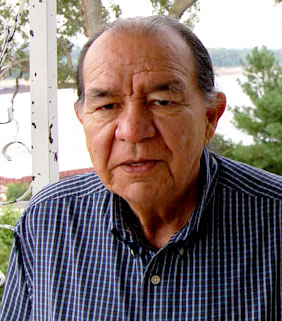 |
Canku Ota
|
 |
|
(Many Paths)
|
||
|
An Online Newsletter
Celebrating Native America
|
||
|
June 2015 - Volume 13
Number 6
|
||
|
|
||
|
Wa Nah Zhi, The Whip
Man
|
||
|
by Charles Red Corn,
Osage News columnist
|
||
It was well over a century ago the Ponca and Kaw people gave to the Osage People the three In-Lon-Schka Drums. Those three Drums have experienced much that is good and positive in mankind. There are rules and procedures that are a part of the Dance. The Drum came at a time when Osages were putting aside much of traditions that had evolved over the centuries; not because they did not want to continue them, there was simply no way in that period could the animals and other parts of nature be obtained, and they did not want to perform anything less than the true ceremony The Committee is formed by the family of a new Drumkeeper, who select a Head Committeeman. He and the family of the new Drumkeeper select Elders to advise the Committee that includes several Dancers, gifted men and women Singers who are keeping the music alive for future generations, and a Town Crier to inform the People of what is happening and to aid those who wish to call out information to those present. The Committee also has Cooks to prepare traditional foods and Fire Men to create the fire that will cook the food, and that Fire is sacred, the Old People have told us. Also, there are Water Boys to keep the Dancers supplied with drinking water. Each of the three Drums have four Tail Dancers, each of them are there to assure that each and every song will end in a perfect way. For each of the three Committees there is a Whip Man. It is the Whip Man's responsibility to maintain Order, and each Whip Man carries a whip as a symbol of his authority. When Dancers enter the Dance Arbor there is a Whip Man there to greet him. Many Dancers will enter the Dance Arbor as a Committee, or as a smaller family group, or as individual Dancers, or as visiting Dancers from other tribes. When the Whip Man has greeted the Dancers he will then walk them to benches that are their assigned seating. When something is not right under the arbor the Head Committeeman will ask the Whip Man to make the situation right. If, say, a Dancer should drop an Eagle Feather to the ground that is the Dance Arbor floor, the Dancer will not pick up the Feather. Rather, the Dancer will return to his seat and wait until the song has ended. Then, the Whip Man will return the Feather to the Dancer. Many years ago during the evening dance under the Pawhuska arbor a photographer set up bright lights and was starting to take pictures of the Dancers. At the direction of the Head Committeeman the Whip Man asked the photographer to remove himself from the Dance Ground, and it all played out in an orderly manner. That is what the Old People meant by Order. The Drumkeeper created a ban on cameras during that time. Over the years the number of the People who take part in In-Lon-Schka have increased, and the procedures and rules of In-Lon-Schka that are bedded deep in the ancient past have made that growth possible. It is an example of how rules and procedures that were laid down verbally can endure, when the People believe in those who created the rules. In today's world and during the dance, with the Drum getting stronger, the Women and Men voices singing those ancient songs, with bells ringing in unison, knowing your ancestors are watching, it is quite an experience. I have no doubt that taking part in In-Lon-Schka has aided People to find a deeper sense of meaning for their lives. Those Old Osages knew what they were doing. |
||
|
|
||
|
|
||
| Canku Ota is a free Newsletter celebrating Native America, its traditions and accomplishments . We do not provide subscriber or visitor names to anyone. Some articles presented in Canku Ota may contain copyright material. We have received appropriate permissions for republishing any articles. Material appearing here is distributed without profit or monetary gain to those who have expressed an interest. This is in accordance with Title 17 U.S.C. Section 107. | ||
|
Canku Ota is a copyright ©
2000 - 2015 of Vicki Williams Barry and Paul Barry.
|
||
 |
 |
|
|
The "Canku
Ota - A Newsletter Celebrating Native America" web site and
its design is the
|
||
|
Copyright ©
1999 - 2015 of Paul C. Barry.
|
||
|
All Rights Reserved.
|
||
